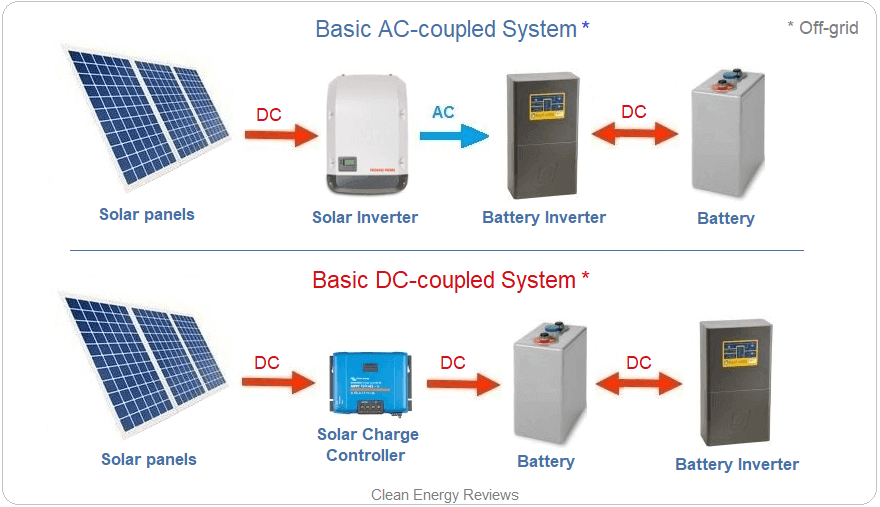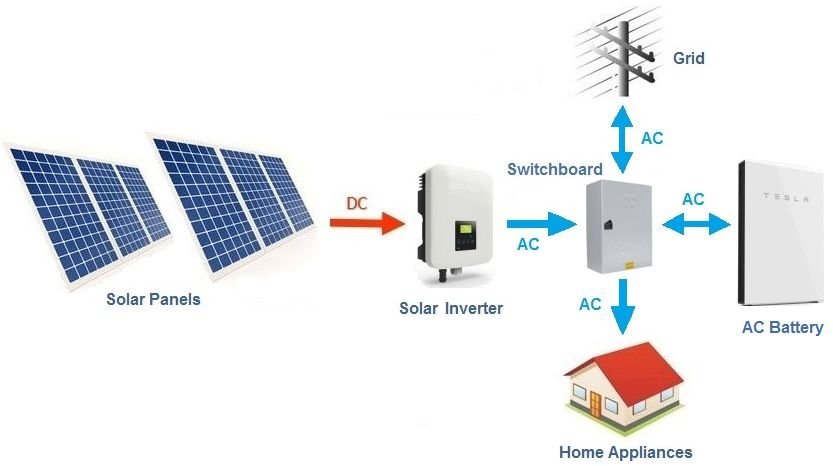Solar battery system types - AC Vs DC coupled
What is AC and DC-coupling?
Put simply, AC or DC-coupling refers to how solar panels are coupled or linked to a battery system. The type of electrical connection between a solar array and a battery can be either Alternating Current (AC) or Direct Current (DC). AC is when the current flows rapidly forward and backward (this is what the electricity grid uses to operate), and DC is where the current flows in one direction. Most electronic circuits use DC, while solar panels produce DC, and batteries store DC energy. However, most electrical appliances operate on AC. This is why all homes and businesses have AC circuits. DC can be converted to AC using an inverter, but as explained below, some energy is always lost.
Quick Summary
DC-coupling using solar charge controllers is the best option for small mobile systems used in RVs and caravans, and for smaller-scale residential off-grid systems. AC-coupling using solar inverters is far more efficient for grid-tie energy storage systems and larger-scale off-grid systems, especially when the daytime loads are high. The full range of advantages and disadvantages of each system type is explained in detail below.
The four main solar System types
DC-coupled systems - Off-grid
AC-coupled systems - Off-grid
AC-coupled Battery Systems - Grid-connected
DC-coupled Hybrid Systems - Grid-connected
Generally, only DC or AC-coupled systems are used for off-grid solar installations. We explain the reasons below, plus a comparison of AC vs DC-coupled solar for off-grid power systems.
1. DC-Coupled systems - Off-grid
For decades, DC-coupled systems have been used in off-grid solar installations and small-capacity automotive/boating power systems. The most common DC-coupled systems use solar charge controllers, also known as solar regulators, to charge a battery directly from solar. These systems typically use a battery inverter to supply AC power to household appliances, as shown in the energy flow diagram below.
Basic layout diagram of a DC-coupled (off-grid) solar battery system using an MPPT solar charge controller
For micro-systems, such as those used in caravans, boats or huts, simple PWM-type solar controllers are a very low-cost way to connect 1 or 2 solar panels to charge a 12-volt battery. PWM (pulse width modulation) controllers come in many sizes and cost as little as $35 for a small 10A version.
For larger systems, MPPT solar charge controllers are up to 30% more efficient and available in sizes up to 200A. Unlike simple PWM controllers, MPPT charge controllers can operate at much higher string voltages, typically up to 450 Volts DC. However, this is still relatively low compared to grid-tie solar string inverters, which typically operate from 200-800 Volts DC. Due to the common 150V upper voltage limitation of many low-cost MPPT solar controllers, a maximum of 3 panels can be linked in series, which means for larger solar systems above 3kW, the installation can become more complex and involves combining strings of panels in parallel with fuses.
Advantages
Very high efficiency - up to 99% battery charging efficiency (using MPPT)
Great for off-grid systems and provides a black start capability
Modular - Additional panels and controllers can be easily added if required.
Ideal for powering DC appliances and loads.
If a grid service provider restricts or limits the capacity of a grid-tie solar inverter (ie. 5kW max), additional solar may be added by DC-coupling a battery system and MPPT charge controllers.
Disadvantages
It can become expensive for systems above 6kW as multiple higher voltage solar charge controllers are required.
Lower efficiency if powering large AC loads during the day due to the conversion from DC to DC, then from DC to AC.
It is more complex to set up larger systems as multiple strings are required in parallel, plus string fusing.
Some solar charge controllers are incompatible with ‘managed’ lithium battery systems such as the LG Chem RESU or BYD B-Box
Recommended DC-Coupled off-grid Systems
Victron Energy Multiplus inverters and solar charge controllers.
Selectrconic SP PRO multi-mode inverters DC-coupled with the AERL charge controllers.
Outback Power Radian, FXR Inverters & FLEXmax MPPT solar controllers.
Schneider Conext XW+ with Conext MPPT controllers (See video review).
2. AC-Coupled systems - Off-grid
Advanced AC-coupled systems are often used for larger-scale off-grid systems and use a common string solar inverter coupled with a multi-mode inverter or inverter-charger to manage the battery and grid/generator. Although relatively simple to set up and very powerful, they are slightly less efficient (90-94%) at charging a battery compared to DC-coupled systems (98%). However, these systems are more efficient at powering high AC loads during the day, and some also can be expanded with multiple solar inverters to form microgrids. AC-coupled systems are ideal for electric vehicle (EV) charging using solar, as regular home wallbox EV chargers are all powered by AC, and the charging load is generally very high.
Basic layout diagram of an AC-coupled solar battery system - Grid-tie (hybrid) setup
Many modern off-grid homes use AC-coupled systems due to the advantages of using string solar inverters with higher DC voltages (up to 600V or higher). This allows much larger solar arrays to be easily installed at lower cost and complexity compared to DC-coupled systems requiring multiple MPPT charge controllers. Larger 3-phase commercial systems, which require much larger solar arrays, use AC coupling with larger 10 to 20kW+ solar inverters.
Advantages
Higher efficiency when used to power AC loads during the day, such as air-conditioning, pool pumps, and hot water systems (up to 97% efficient).
Ideal for solar EV charging when using regular home wallbox EV chargers
Generally lower installation cost for larger systems above 6kW.
Can use multiple string solar inverters in multiple locations (AC-coupled micro-grids)
Most string solar inverters above 3kW have dual MPPT inputs, so long strings of panels can be installed at different orientations and tilt angles.
Advanced AC-coupled systems can use a combination of AC and DC coupling (Note: this is not possible with some ‘managed’ lithium batteries)
Disadvantages
Lower efficiency when charging a battery system - approx 86% to 92%
Solar Inverter capacity may be limited to the Inverter-charger size (i.e. Victron 1:1 ratio).
Quality Solar inverters can be expensive for small systems.
Low efficiency when powering DC loads.
Recommended AC Coupled systems
Selectronic SP PRO inverter-chargers and FIMER or Fronius solar inverters.
SMA Sunny Island and SMA sunny boy inverters.
Victron Energy Multiplus or Quattro inverters and Fronius solar inverters.
3. AC-Coupled Batteries - Grid Connected
AC-coupled batteries, or simply AC batteries, allow batteries to be easily AC coupled to a new or existing solar installation. AC batteries consist of lithium battery modules, a battery management system (BMS) and an inverter in one compact unit that can be easily connected to most homes.
These systems are generally only designed for grid-connected homes, not off-grid homes, as the (transformerless) inverters are typically not powerful enough to run a home completely off-grid and cannot handle the surge loads of many appliances. The most well-known AC battery is the Tesla Powerwall 2, along with the SonnenBatterie, which is more common in Europe and Australia. Leading microinverter company Enphase Energy also manufactures AC battery systems for home use.
Basic layout diagram of a AC battery coupled with solar inverter - Grid-tie (no backup shown)
Another option is to use a ‘retrofit’ AC coupling inverter to create an AC battery system. These systems use specialised AC coupling inverters such as the SMA sunny boy storage together with a common DC battery such as the popular LG chem RESU or BYD HVM.
Advantages
Easy retrofit - can be added to homes with an existing solar installation
An economical way to add energy storage.
Generally simple to install.
Modular system to allow expansion.
Disadvantages
Lower efficiency due to conversion (DC - AC - DC) - approx 90%
Some AC batteries cannot function as a backup supply
Generally not designed for off-grid installations.
Recommended AC Battery Systems
SonnenBatterie ECO
Goodwe SBP series - AC Retrofit inverters
4. DC-coupled Hybrid systems - Grid connected
Hybrid systems can be described as grid-tie DC-coupled solar battery systems. They come in many different configurations and typically use a hybrid (multi-mode) inverter. Modern hybrid inverters incorporate high voltage MPPT controller/s and a battery inverter inside a common unit. The first generation hybrid inverters were compatible with 48V lead-acid or lithium battery systems. However, higher voltage (400V+) battery systems have become increasingly popular.
Basic layout diagram of a hybrid solar inverter with DC battery system
High Voltage Vs Low Voltage systems
High-voltage batteries operate in the range of 200-500V DC (400V nominal) as opposed to the traditional 48V battery systems. This offers several advantages, including lower cable losses and improved efficiency, as the solar array typically operates at 300-600V, which is very similar to the battery voltage. Higher voltage (400V) batteries and compatible hybrid inverters use lithium battery systems operating between 120-500V rather than 48V.
Since most solar arrays operate at high voltages, around 300-600V, high-voltage batteries use efficient DC-DC converters with very low losses. The BYD HVM series batteries are some of the most popular HV battery systems, being compatible with many hybrid inverters, including SolarEdge StorEdge and Fronius GEN24 Plus.
Advantages
Economical, compact and simple to install
High-efficiency battery charging - approx 96%
Compact, modular battery options
Smaller cable size and low losses using high voltage batteries
Can be retrofitted to 'some' existing solar installations.
A growing number of hybrid inverters are now available
Disadvantages
Some systems cannot function as a back-up power supply
Many systems with back-up have a 3-5 second delay during a blackout
Generally not suitable for off-grid installations due to transformerless hybrid inverters with low surge rating and no generator controls.
Recommended Hybrid systems
Sungrow SH-RT series and Sungrow SBR HV battery (New)
Huawei SUN2000L1 and Huawei Luna2000 battery
SolarEdge StorEdge inverter and BYD HVM
AC vs DC-coupled for off-grid systems
Why would you use an AC-coupled off-grid system rather than DC-coupled?
Modern AC-coupled off-grid systems use solar inverters to convert solar DC power directly to AC, which can then be used immediately by most appliances during the day. This is very efficient, especially when powering high loads such as air-conditioning systems, modern kitchen appliances and water/pool pumps. Additionally, the installation cost of AC-coupled string solar inverters is lower for larger systems above 6kW due to the multiple MPP trackers, higher string voltage up to 1000V, and higher capacities up to 10kWp single phase.
Battery charge control and frequency ramping
If an AC-coupled system is used off-grid, the solar inverter must be compatible with the (multi-mode) battery inverter/charger to enable precise charge control. This is required so the solar generation can be 'managed' or ramped up and down to ensure safe and accurate battery charging. Several management systems are used by different manufacturers, such as frequency ramping (used by SMA and Victron) or direct communication as used by Selectronic combined with Selectronic certified or Scert solar inverters - refer to manufacturers’ specifications.
As explained previously, DC-coupled systems are very cost-effective for small to medium size systems. Another advantage of DC-coupled systems is that solar controllers are very flexible and scalable, meaning additional panels can be easily added if required using low-cost DC solar controllers.
DC-coupled High voltage MPPT solar charge controllers
Higher voltage MPPT solar charge controllers are available, up to 450V from Victron Energy and 600V from AERL in Australia, enabling much longer strings using larger solar arrays up to 6kW. There are also higher 600V units available from Schneider Electric and Morningstar, although these are much more expensive and don't have multiple MPPT inputs like many solar string inverters. High voltage MPPT charge controllers are a very efficient and secure way of ensuring batteries are charged even during an AC shutdown - this is especially important in remote locations.
Combined AC and DC-coupling - off-grid
Most modern off-grid inverters, such as the Selectronic SP PRO, SMA Sunny Island and Victron Multiplus, can function in both AC and DC-coupled configurations. This offers the best of both worlds and provides backup DC battery charging in the event of an AC shutdown.
Combination AC and DC-Coupled system - Can be configured as Grid-interactive or Off-grid with generator
If there is an inverter shutdown in a remote location due to low battery voltage or low SOC, the DC-coupled solar charge controllers will continue to function (without AC operation) and recharge the battery system, which preserves the battery life and can restart the system if configured correctly. This is a more fail-safe setup, unlike pure AC-coupled systems, which are sometimes unable to be automatically or remotely restarted unless a backup generator or AC source is functioning.
A combined AC and DC-coupled off-grid solar system - Selectronic SP PRO AC coupled to a Kaco solar inverter. The lead-acid battery bank is also charged with two DC-coupled Victron MPPT solar controllers.
Disclaimer: This is a guide only. Solar and battery storage systems must be installed by a licensed electrical or solar professional. For less technical information, see the basic guide to selecting a grid-tie or off-grid solar battery system. Solar and battery systems can generate and store huge amounts of energy, which can result in damage or serious injury if installed incorrectly and the installation does not meet all relevant regulations, standards & industry guidelines.







